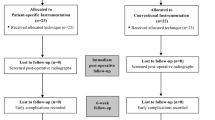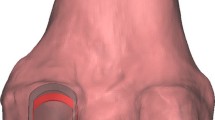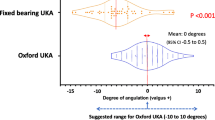Abstract
Purpose
Implant position is an important factor in unicompartmental knee arthroplasty (UKA) surgery. Results on conventional UKA alignment are commonly described in literature. Patient-specific guiding (PSG) is a new technique for positioning the Oxford UKA. Our hypothesis is that PSG improves component position without affecting the HKA angle.
Methods
This prospective study compares the results of our first thirty cases of cementless Oxford UKA using PSG with thirty cases using conventional outlining. Baseline characteristics for both groups were identical. Details on handling of the guide, estimated blood loss and operation time were recorded. Postoperative screened radiographs and standing long-leg radiographs of both groups were compared.
Results
Median AP position of the femoral component was 3 degrees varus (−5 to 9) using PSG versus 2 degrees varus (−10 to 8) for the conventional group. For the femoral flexion, this was 9 degrees flexion (0–16) using PSG versus 12 degrees flexion (0–20). The tibial median AP position was 1 degree varus (−3 to 7) using PSG versus 2 degrees varus (−5 to 10). The median tibial posterior slope was 5 degrees (1–10) using PSG versus 5 degrees (0–12). All guides aligned well. No conversion to conventional outlining was performed, and no significant changes had to be made to the original approved plan. Operation time, estimated blood loss and postoperative haemoglobin drop were not significantly different between both groups.
Discussion
Implant position was not different between both groups, even in the early phase of the learning curve. Perioperative results were not different between both groups.
Level of evidence
III.


Similar content being viewed by others
References
Boonen B, Schotanus MG, Kort NP (2012) Preliminary experience with the patient-specific templating total knee arthroplasty. Acta Orthop 83:387–393
Clarius M, Hauck C, Seeger JB, Pritsch M, Merle C, Aldinger PR (2010) Correlation of positioning and clinical results in Oxford UKA. Int Orthop 34:1145–1151
Jenny JY, Boeri C (2002) Accuracy of implantation of a unicompartmental total knee arthroplasty with 2 different instrumentations: a case–controlled comparative study. J Arthroplasty 17:1016–1020
Jenny JY, Boeri C (2003) Unicompartmental knee prosthesis implantation with a non-image-based navigation system: rationale, technique, case–control comparative study with a conventional instrumented implantation. Knee Surg Sports Traumatol Arthrosc 11:40–45
Jung KA, Kim SJ, Lee SC, Hwang SH, Ahn NK (2010) Accuracy of implantation during computer-assisted minimally invasive Oxford unicompartmental knee arthroplasty: a comparison with a conventional instrumented technique. Knee 17:387–391
Keene G, Simpson D, Kalairajah Y (2006) Limb alignment in computer-assisted minimally-invasive unicompartmental knee replacement. J Bone Joint Surg 88:44–48
Koeck FX, Beckmann J, Luring C, Rath B, Grifka J, Basad E (2011) Evaluation of implant position and knee alignment after patient-specific unicompartmental knee arthroplasty. Knee 18:294–299
Kort NP, van Raay JJ, Cheung J, Jolink C, Deutman R (2007) Analysis of Oxford medial unicompartmental knee replacement using the minimally invasive technique in patients aged 60 and above: an independent prospective series. Knee Surg Sports Traumatol Arthrosc 15:1331–1334
Kort NP, van Raay JJ, van Horn JJ (2007) The Oxford phase III unicompartmental knee replacement in patients less than 60 years of age. Knee Surg Sports Traumatol Arthrosc 15:356–360
Parmaksizoglu AS, Kabukcuoglu Y, Ozkaya U, Bilgili F, Aslan A (2010) Short-term results of the Oxford phase 3 unicompartmental knee arthroplasty for medial arthritis. Acta Orthop Traumatol Turc 44:135–142
Conflict of interest
One author (NK) lectures on the SPPC operation technique for Biomet. The other authors declare that they have no conflict of interest.
Author information
Authors and Affiliations
Corresponding author
Rights and permissions
About this article
Cite this article
Kerens, B., Schotanus, M.G.M., Boonen, B. et al. No radiographic difference between patient-specific guiding and conventional Oxford UKA surgery. Knee Surg Sports Traumatol Arthrosc 23, 1324–1329 (2015). https://doi.org/10.1007/s00167-014-2849-0
Received:
Accepted:
Published:
Issue Date:
DOI: https://doi.org/10.1007/s00167-014-2849-0




